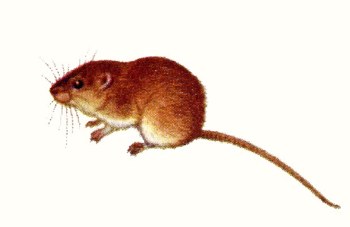Pests
Micromys minutus Pallas - Old World Harvest Mouse.
Systematic position.
Class Mammalia, order Rodentia, family Muridae, genus Micromys. There are no more than 3 subspecies in the fauna of the Former Soviet Union.Biological group.
Pest rodents.Morphology and biology.
Small mouse; body length to 70 mm, tail length to 65 mm (it is equal to body length on average). Tail is brawny (in contrast to other Palaearctic mouse species), very movable, being able to twine round stems and thin branches. Foot is rather long, to 14 mm. Eyes are small, and ears are short. Coloration of the upper part is monotone, with brownish and reddish tints, especially in hind part of the back. Belly is white or light gray; the border between upper and lower body colorations is sharp. Fur is soft; bristly hairs are long and thin. Diploid chromosome set is 2n=48. This animal inhabits southern part of forest and forest-steppe zones. It penetrates along river valleys deep to the north, to Polar Circle. In mountains (in corresponding zones) it reaches 2200 m above sea level (central part of the Greater Caucasus Mountain Ridge). It lives in open places with tall and dense vegetation, often near water. Typical habitats in arable lands are agricultural fields, haylands, vegetable gardens, boundary strips, and fallow lands.Distribution.
This is a widespread species, inhabiting most of Western Europe, Northern Mongolia, South and South-East Asia. Within the Former Soviet Union occurs almost throughout European part (except north), Northern Kazakhstan, Southern Siberia and the Far East.Ecology.
Round-the-clock activity. This species is very susceptible to overheating and to direct sunlight. In cold season it lives in simply constructed burrows or occupies burrows of other rodent species; in warm season it builds ball-like nests, using leaves and stems of different grasses; the nests are fastened at a height of 40 to 60 cm (more rarely up to 1 m). M. minutus feeds on seeds of cereals, legumes, broad-leaved tree species, and also on insects and their larvae. It produces 2-3 broods during a year, there are 7-8 (to 12) young mice in a brood on average. In autumn and winter it migrates to haystacks and ricks, where population density may be very high. Population numbers are subjected to significant fluctuations, mainly because of weather conditions. These animals die in large numbers during rainy seasons and in winters with small amount of snow, under freshets and floods, spring burning of grass and machine harvest by combines.Economic significance.
Pest of grain crops. It may cause considerable yield damage (southern Primorskii Territory) in time of outbreaks and significant increases in population density. Natural carrier of pathogens of tularemia, leptospirosis, Japanese encephalitis, and other dangerous diseases. Control measures include full plowing of fields without gaps; timely and high-quality harvest; removal of plant remains, haystacks and ricks from fields.Reference citations:
Gromov I.M., Erbaeva M.A. 1995. Mammals of the fauna of Russia and adjacent territories. Leporids and Rodents. In: Aristov A.A., Baranova G.I., editors. Keys to fauna of Russia, published by Zoological Institute of RAS, Issue 167. Saint Petersburg: ZIN RAN. 552 p. (In Russian)Kostenko V.A., Nesterenko V.A. 1989. Rodents of cultivated lands in Primorskii Territory. Vladivostok: DVO AN SSSR. 64 p. (In Russian)
Popov V.A. 1960. Mammals of Volga-Kama Territory. Kazan: AN SSSR, Kazan filial. 468 p. (In Russian)
Sleptsov M.M. 1947. To the biology of Micromys minutus ussuricus Barr-Ham. In: Fauna i ekologia gryzunov. Issue 2. Moscow: MOIP. 69-100 p. (In Russian)
Sokolov I.I., ed. 1963. Mammals in fauna of the USSR. Part I. Leningrad: AN SSSR. 638 p. (In Russian)


